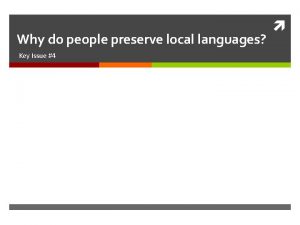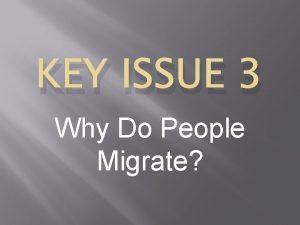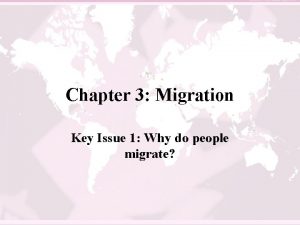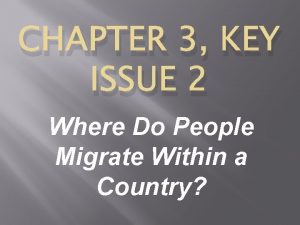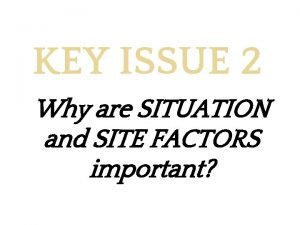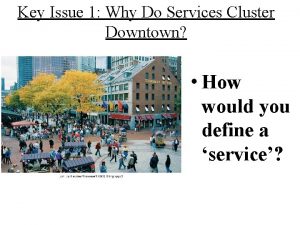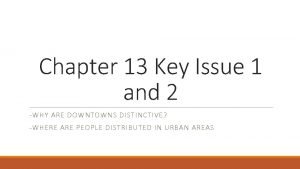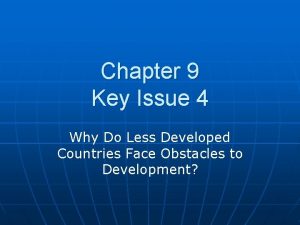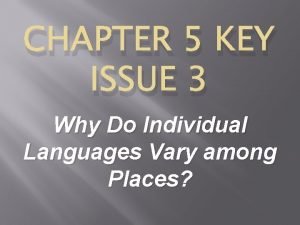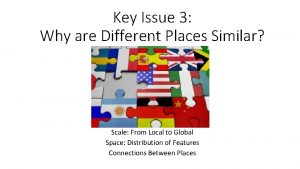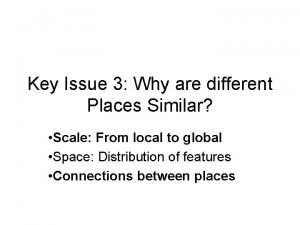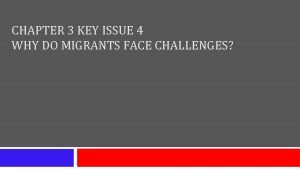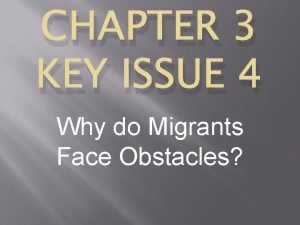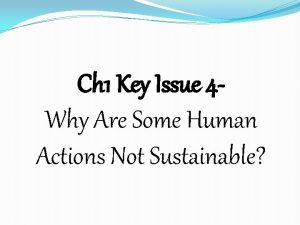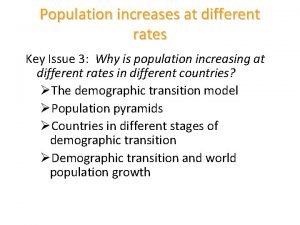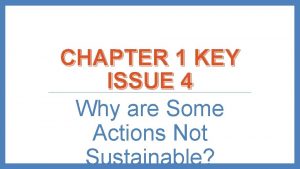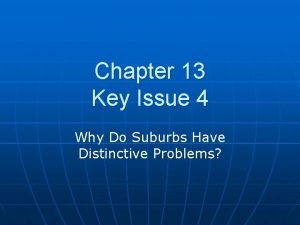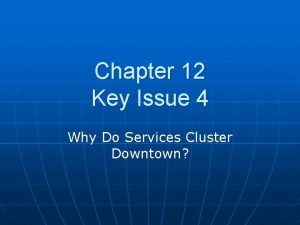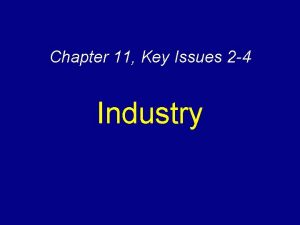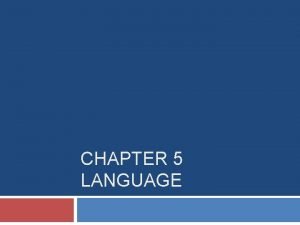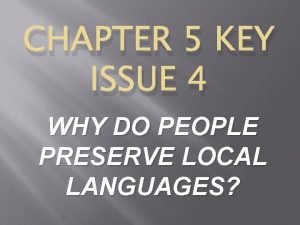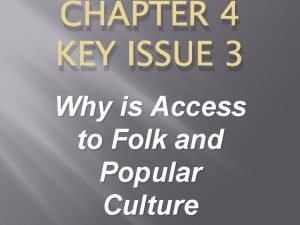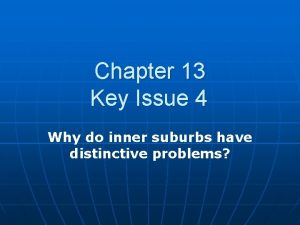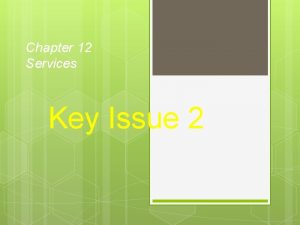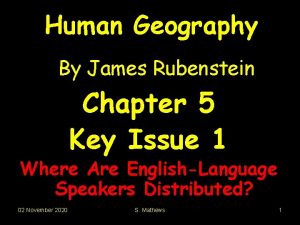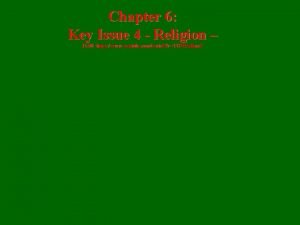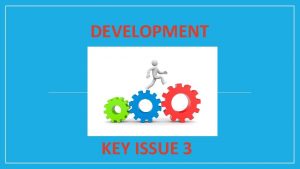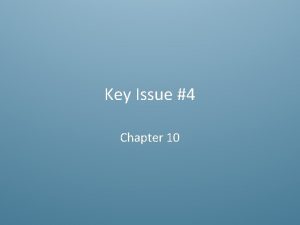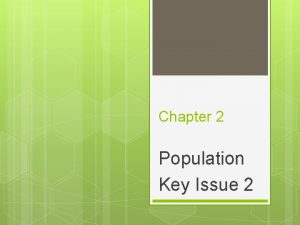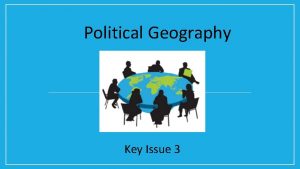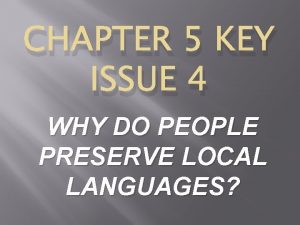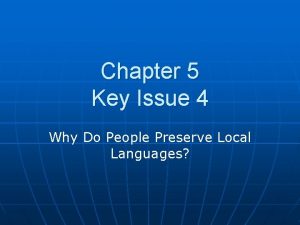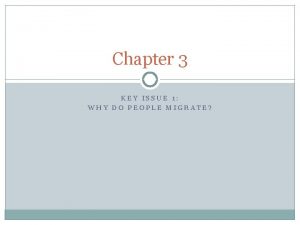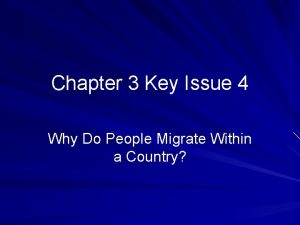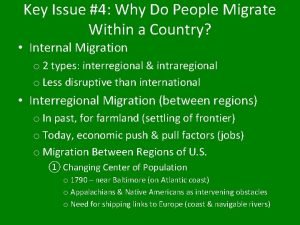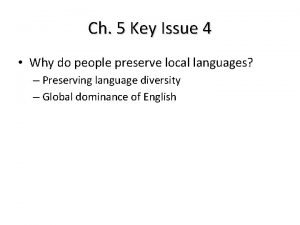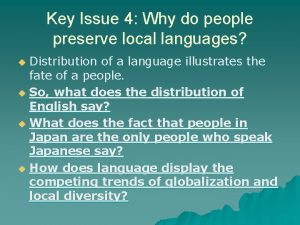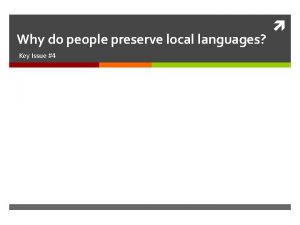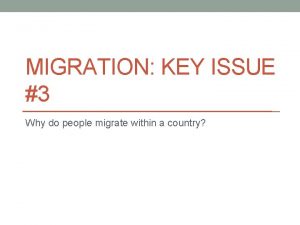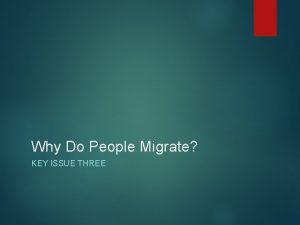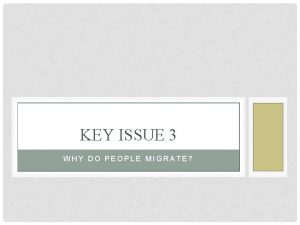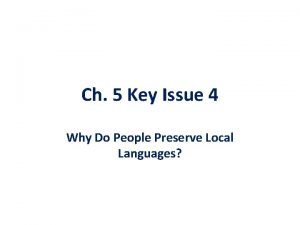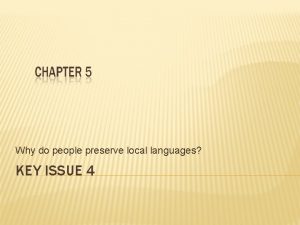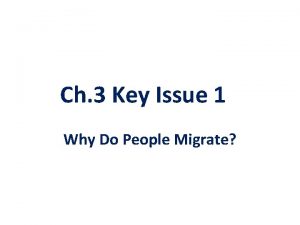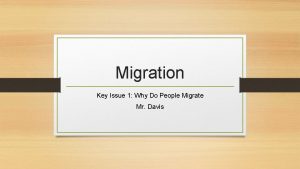Chapter 3 KEY ISSUE 1 WHY DO PEOPLE




























- Slides: 28

Chapter 3 KEY ISSUE 1: WHY DO PEOPLE MIGRATE?

Ravenstein’s Laws of Migration 19 th century used data from England to outline a series of “laws” explaining patterns of migration Migration impacted by push/ pull factors Unfavorable conditions push people out of a place Attractive opportunities pull people to a place Economic factors are main cause of migration Most migrants move only short distance Each migration flow procedures a compensating counter-flow Long-distance migrants go to centers of commerce and industry (economic opportunity) Urban residents are less migratory than those from rural areas Factors such as gender, age, and socioeconomic level influence likelihood to migrate Three categories: Why migrants move Distance they typically move Characteristics of migrants

Gravity Model of Spatial Interaction Applied to migration Larger places attract more migrants than smaller places do. Destinations that are more distant have a weaker pull effect than do closer opportunities if the same caliber. Aka closer places attract more migrants than more distant places. Mathematically Multiplication of two populations divided by the distance b/w them Gravity Model proposes an equation that balances distance and size in trying to predict spatial patterns Limitations Does not factor selectivity factors Age Education level Human behavior does not always fit into predicted patterns

Terms Migration: long-distance move to a new location Net Migration: Emigration: moving from a particular location ( out-migration) Immigration: moving to a particular location (inmigration) Mobility: Migration Stream: Pathway from a place of origin to a destination Migration counterstream: people moving back to the place of origin from the new place Gross Migration: total # of migrants moving into and out of a place, region, or country. gain or loss in the total population of that area as a result of migration. Net in-migration More immigrants than emigrants Net out-migration More emigrants than immigrants ability to move from one place to another, either permanently or temporarily. Circulation: short term, repetitive, or cyclical movements that recur on a regular basis, such as daily, monthly, or annually.

Why is it important? Data has social, political, and economic consequences: Out-mig. of highly trained professionals from Cuba, leaves Cuba with providing health care. Low-labor costs have drawn low-skilled in-migrant workers Can cause political issues • Example, the U. S. accusations that immigrants are “stealing” American jobs Geographers concerned with why people migrate Changing scale has had major implications on migration With globalization, why do people still migrate?

I. Reasons for Migrating Most people migrate for economic reasons Cultural and Environmental factors also induce migration Not as frequent as economic factors

PUSH/PULL FACTORS A push factor induces people to move out of their present location A pull factor induces people to move into a new location Three kinds of push/pull factors: Economic Cultural Environmental

Economic Push/Pull Factors Push Factors Not enough job opportunities Pull Factors Areas with lots of natural resources Job opportunities Areas like US and Canada attracted immigrants because of economic opportunities American dream Places that one people emigrated from, like Scotland, are now immigration “hot spots” due to new natural resources discovered.

Cultural Push/Pull Factors Forced international Migration Slavery Political instability Recent Example: Lebanese and Kurds Scattered due to war and civil strife Lebanon lost a large # of population to migrations Kurds never established autonomous state Many left due to military aggression, and persecution Other examples Jews Deportation of Armenians after WWI Palestinians after establishment of Israel.

Environmental Factors Pull Factors Attractive locations Mediterranean coast of France Alps Rocky Mountains climate Arizona people with Asthma, allergies Flordia beach, warm winters Thanks to improved technology people can live anywhere Air conditioning Transportation communications

Environmental Push Factors Adverse physical conditions Flooding Hurricane Katrina Natural Disaster Japanese earthquake Nuclear radiation Irish Potato Famine Drought Great Depression Migration Sahel region of Northern Africa


Great Depression Migration

Intervening Obstacles Where migrants go is not always their desired destination Blocked by intervening obstacle Today: Transportation allows for more migration In the past, mainly environmental Migration was on horse or foot example: people trying to reach California during the gold rush often couldn’t cross Rocky Mountains, Great plains, or desert. European Migration to America hindered by crossing the Atlantic Ocean Sometime were told they were going to America, but weren’t taken there!! Trains, cars, airplanes More political issues Passports documentation

II. Distance of Migration Ravenstein’s laws Most migrants relocate short distance and remain within same country Long-distance migrants to other countries head for major centers of economic activity Migration Internal migration Movement within a country Types: Interregional Intraregional International migration Permanent movement from country to country Voluntary/ Forced Voluntary- choice to move Forced- pushed from land

Internal Migration Permanent movement within the same country Shorter distances Easier cultural assimilation Two Types: Interregional movement from one region to another region within the same country From Bluffton, SC to Boston, Mass) Intraregional movement within one region From a city to suburb Example: • From Bluffton, SC to Hilton Head, SC

Historical Internal Migration : U. S. 1 st wave Westward settlement Manifest destiny From Eastern seaboard to West Coast Rural-to-urban Industrialization cause New jobs 2 nd wave 1940 s- 1970 s African-Americans migrating from rural south To cities in South, North, and West Mechanization of cotton Defense jobs (WWI, WWII) 3 rd wave Cold War jobs Emergence of Sunbelt West/ Mid-west growth too Economic opportunity Air conditioning Cheap land

Internal Forced Migration “Trail of Tears” Cherokee Indians forced to leave Georgia for Oklahoma Forced “Eco-Migration” China Mao’s cultural revolution 10 -17 million South Africa Apartheid, 1960 -1980 3. 6 million Bangladesh floodplain settlement of 1960’s Ethiopia famine of 1984 -1985 New Examples: Yemen running out of water China desertification Louisiana/ Alaska rising sea levels

International Migration Permanent movement from one country to another Two types: Voluntary the migrant has chosen to move • Economic reasons Forced migrant has been compelled to move by cultural factors

International Voluntary Migration Usually occurs due to high wage differentials, job opportunities, family links, unemployment conditions, etc. Temporary labor migration- guest workers Transnational migrants: set up homes and/or work in more than one nationstate Mexican migrants Asian migrants

International Forced Migration: Refugees are a case of forced migration Refugee: People who have been forced to migrate from their homes and cannot return for fear of persecution because of their race, religion, nationality, membership in a social group, or political opinion. individuals who cross national boundaries to seek safety asylum 14 million refugees in 2007

Refugees Large refugee movement from Central Asia and Afghanistan after Sept. 11 th Two largest groups of international refugees: Palestinians Afghans Two largest groups of internal refugees Sudan Colombia

Major Regions of Refugees Sub-Saharan Africa Tribal Ethnic Conflicts Darfur Religious/ ethnic tensions War-related Rwanda, Congo Sudan Europe Fall of Yugoslavia/ Balkans Zaire, Tanzania, Uganda, Liberia, Sierra Leone, Angola, and Burundi The Middle East Palestinians Kurds 7 million refugees Southeast Asia Vietnam Cambodia 30, 000 refugees Burma/ Myanmar Dictatorial government South Asia Afghan refugees Sri Lanka 1 million

Internally Displaced Person IDPs: Individuals who are uprooted within the boundaries of their own country because of global conflict or human rights abuse

Zelinsky Model of Migration Transition Identified by Wilbur Zelinsky Change in migration pattern in a society that results from social and economic changes that also produce the demographic transition. Stage 1 High CBR/ High CDR Daily or seasonal mobility in search of food Searching for local necessities temporary Internal migration Stage 2 High CBR/ dropping CDR High rate of Natural Increase Overtaxing resources/ limited opportunities push out immigrants Like decline in death rate, migration a result of technological change International Migration and Interregional Migration Rural areas to cities

Migration Transition Model Stage 3 & 4 Slowing growth rate Result of social change Fewer children Principal destinations for international migrants International Migration Societies in stage 3 & 4 become the destinations of migrations from stage 2 countries Stage 4: Less emigration, more intraregional migration From cities to suburbs

III. Characteristics of Migrants Gender Ravenstein’s Laws Most long-distance migrants are male Most long-distance migrants are adult individuals Reality Reversed in 1990 s women now 55% of U. S. immigrants Mexican Immigration Similar patterns • Up until 1980’s 85% of Mexican immigrants men • Now women majority Family Status Most immigrants young adults Ravenstein right! 40% of U. S. immigrants today between 25 -39 years old Increasing # are children 16% under 15 years old

Migration Selectivity Decision to migrate often fits into predictable pattern based on age, income, and other socioeconomic factors Migration selectivity Evaluation of how likely someone is to migrate based on personal, social, and economic factors Age Most influential factor in migration selectivity Americans are most likely to move between 18 and 30 Education The more educated people are the more likely they are to make long-distance moves Brain-drain Educated people leave KY- Appalachian region Brain-gain
 Languages
Languages Key issue 3 why do people migrate
Key issue 3 why do people migrate Chapter 3 key issue 1
Chapter 3 key issue 1 Hey hey bye bye
Hey hey bye bye Key issue 2: where do people migrate within a country?
Key issue 2: where do people migrate within a country? Why are situation and site factors important
Why are situation and site factors important Key issue 1: why do services cluster downtown?
Key issue 1: why do services cluster downtown? Why are downtowns distinctive
Why are downtowns distinctive Chapter 9 key issue 4
Chapter 9 key issue 4 Key issue 3: why do individual languages vary among places?
Key issue 3: why do individual languages vary among places? Why are different places similar
Why are different places similar Why are different places similar
Why are different places similar Chapter 3 key issue 4
Chapter 3 key issue 4 Key issue 4: why do migrants face obstacles?
Key issue 4: why do migrants face obstacles? Key issue 3 why do some places face health challenges
Key issue 3 why do some places face health challenges Key issue 4 why are some human actions not sustainable
Key issue 4 why are some human actions not sustainable Key issue 3 why does population growth vary among regions
Key issue 3 why does population growth vary among regions Key issue 4 why are some actions not sustainable
Key issue 4 why are some actions not sustainable Chapter 13 key issue 3
Chapter 13 key issue 3 Key issue 1: where are services distributed?
Key issue 1: where are services distributed? Chapter 12 key issue 4
Chapter 12 key issue 4 Chapter 11 key issue 4
Chapter 11 key issue 4 Language
Language Chapter 5 key issue 4
Chapter 5 key issue 4 Chapter 4 key issue 3
Chapter 4 key issue 3 Chapter 13 key issue 4
Chapter 13 key issue 4 Key issue 2 where are consumer services distributed
Key issue 2 where are consumer services distributed Received pronunciation definition ap human geography
Received pronunciation definition ap human geography Chapter 6 key issue 4
Chapter 6 key issue 4
